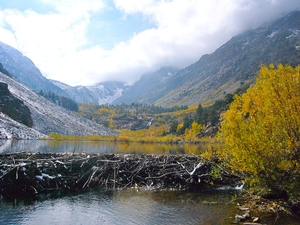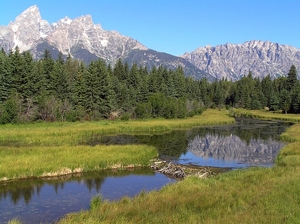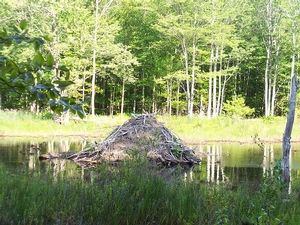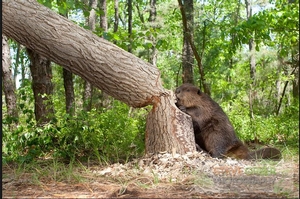Ways in which the beaver CONSERVES:
Beavers are classified as a keystone species because they manipulate their environment in ways that provide room for diverse plant and animal species. Beavers create space for new growth by selectively cutting old growth trees. Clearing old growth allows for young plants to spring up, consequently attracting animals that feed on young growth such as deer. Beaver dams raise the water table of the surrounding area, which makes ground water more accessible for agriculture and domestic use. The heightened water table also provides a prime habitat for diverse pants that require more water than those that already exist in the area. Beaver dams cause flooding that changes the landscape and leads to increased fertility in the surrounding area. Beaver dams also have beneficial effects on annual discharge patterns. Multiple beaver dams in one body of water increase flow in summer months and, in the event of a flood, beaver dams slow overflow and reduce erosion. Beaver dams additionally combat erosion by slowing the velocity of running water and increasing deposition rates, which also decreases decay rates and increases the amount of organic material in the water. Increased organic material and sediment in a body of water provides a nutrient rich environment for aquatic plants and animals. Some of the main resources that beaver dams increase are dissolved oxygen, Nitrogen, and Phosphorus. The pH and ANC levels of dammed water are also higher than in water that is uninhabited by beavers. The increased pH and ANC levels create a less acidic environment, which (along with the increased sedimentary and organic material in the water) creates a prime habitat for diverse plant and animal life in dammed water.
Ways in which the beaver DESTROYS:
Some scientists have expressed concern that beaver ponds in the Adirondacks have increased evaporation due to the dams' capacity to slow water flow. However, other scientists argue that beavers stabilize stream flow and that increased evaporation is not a risk. If a dam fails, it can cause serious flooding that potentially ends plant and animal life in surrounding land for a number of years. A release of unloaded water down steam from a dam can cause serious erosion in specific areas, causing moving water to meander and change course. Raising the surrounding water table and flooding the immediate area can push sediment and organic material into irrigation ditches, spoiling agriculture in the surrounding area. Floods caused by initial dam building can also damage valuable timber in the area surrounding the dam. Some scientists argue that beaver’s harm the diversity of a forest by selectively cutting trees they favor for building dams. Beavers can cause costly damage to the siding on people's homes and they often chew though expensive electric wires.
The effects in italics are ways in which the beaver can be problematic to humans, not the environment.
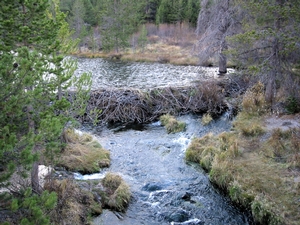 As you can see from the information above, the beaver is a paradoxical creature; it creates and destroys at the same time. Beaver dams flood valuable timber and beavers cut down thousands of trees around their dams. However, the flooding leads to increased fertility in the land, which is favorable to new plant and animal life. Also, the destruction of old growth trees provides a space for new growth trees that attract new species of animals. Even though the beaver destroys life, its actions give way to new life and help conserve the overall environment. The positive effects of the beaver on its environment far outweigh the negative effects. Beavers create and alter wetlands, creating vital habitats for different species and supporting biodiversity. Without the beaver, the numerous biodiverse wetlands that exist in the Adirondacks today would disappear and the park would suffer as it did in the late 19th century and early 20th century when there were barely any beavers left. Even though beavers are considered by many of their human neighbors as a nuisance, they play a crucial role in the environment.
As you can see from the information above, the beaver is a paradoxical creature; it creates and destroys at the same time. Beaver dams flood valuable timber and beavers cut down thousands of trees around their dams. However, the flooding leads to increased fertility in the land, which is favorable to new plant and animal life. Also, the destruction of old growth trees provides a space for new growth trees that attract new species of animals. Even though the beaver destroys life, its actions give way to new life and help conserve the overall environment. The positive effects of the beaver on its environment far outweigh the negative effects. Beavers create and alter wetlands, creating vital habitats for different species and supporting biodiversity. Without the beaver, the numerous biodiverse wetlands that exist in the Adirondacks today would disappear and the park would suffer as it did in the late 19th century and early 20th century when there were barely any beavers left. Even though beavers are considered by many of their human neighbors as a nuisance, they play a crucial role in the environment.
Sources: "Beaver." Dec.NY.Gov. ; "Beaver Castor Canadensis." National Geographic. ; Rosell, Brozsér, Collen, Parker. "Ecological Impact of Beavers Castor Fiber and Castor Canadensis and Their Ability to Modify Ecosystems." ; Haemig, "Ecology of the Beaver.";Robbins, "Reversing Course on Beavers."
Images:
1. http://stevegreerphotograph.photoshelter.com/image/I0000PMtRJkITYJs
2. Wikimedia Commons
